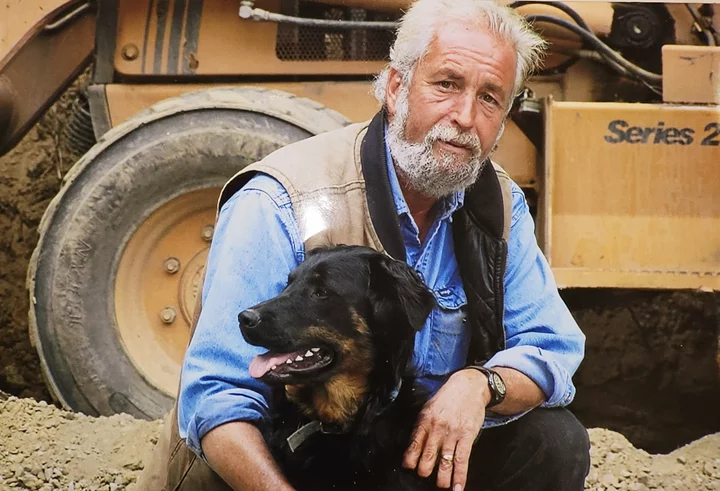OBITUARY: Herbert Steven (Steve) Hoopes, 1953-2023
LoCO Staff / Tuesday, Feb. 27, 2024 @ 6:56 a.m. / Obits
It is with a heavy heart that we share the passing of Steve Hoopes on December 3, 2023.
Steve was born on December 17, 1953, to Herbert and Bonnie Hoopes. He was the youngest of four and their only son.
Donna, Steve’s older sister, described him as very determined and a daredevil at an early age. He also developed a profound love of water when he was young.
His love of adventure and the water carried over to his teen and adult years. It was quite common for Steve to spend time with his dad and stepmom, camping, hunting and fishing. During salmon season, their plan was to catch all their salmon limits, and then freeze them. After the season was over, they picked a date to clean and smoke them. That usually took one weekend. The next weekend they canned them. The bounty would be shared with family and friends who claimed, “This is the best smoked salmon ever!” This tradition carried over when Steve married Arlene and they made many memories partnering with his parents in the fishing, smoking and canning of salmon. This kind of generosity was common for Steve. He took great pleasure in sharing what others enjoyed.
Early in life, Steve developed a strong work ethic. He worked two summers for Dick Young on his fishing boat (City of Eureka). He and his best friend, Rick Lewis, cleaned fillet lines at the Paladini Fishing Company, after school and into the evening. When he was a senior, he worked as an apprentice at Simpson Lumber Mill, as well as taking welding classes and courses on reading blueprints for metal machinery at College of the Redwoods.
After graduation from Eureka High School in 1972, he went to work for Keith Parker at Parker and Son. Steve told the story of his Dad, saying, “If you don’t go to school, you will end up digging ditches all your life!” Steve loved that story and often added, “I got my degree in Tractorology!” and then laughed. He eventually became a partner of Parker and Son and ultimately purchased the business.
Steve loved his tractors and his career. He would often say before leaving for work, “I’m off to build America.” Jim Fuller, his good friend and fellow contractor said of Steve, “He was integral in establishing new subdivisions from Fortuna to McKinleyville, reputable in the digging of underground.” He recalled one job, in which the primary water main blew at College of the Redwoods, causing a bank to wash out and the lake to completely drain. They had to put in a new outlet of 5-foot round pipe running 600 to 800 feet. The job was so big that Hilfiker Pipe Company had to pour pipe everyday to keep up with the daily demands. In 1995, Steve was instrumental in installing the radar station in Petrolia off Wildcat Road. It can be seen when driving on Highway 101 south.
Steve loved working with wood and metal. He could fix anything, as his grandchildren would say. He made wind chimes, bowls, jewelry boxes, lamp bases out of redwood burl for Arlene. He made so many, that he was always sharing them with others. He was especially proud of milling the redwood siding for their home they built together.
The stories of Steve’s willingness to help others with his trusty tractor are endless. The heartfelt experiences, interactions, his way of making one smile and feel special, the foundation poured into his children, stepchildren and grandchildren, cherished friends and extended family, are indelible marks that will never fade. Steve loved as hard as he worked.
He was the rock of our family and fondly called, “Pop.” He is greatly and forever missed. Arlene was truly the love of his life. For Arlene, their love story includes memories of dancing, road trips searching for lighthouses and always opening their home to family and friends.
The day of his passing, December 3, Steve could be found doing the thing he loved most, helping others. He spent the day on his tractor helping his good friend and neighbor Darby Mintey with a project, before returning home to barbecue for his family. When it came to helping others, Steve’s philosophy was, “it’s no big deal, ” but it was to all of us who knew him.
Preceded in death by his father, Herbert Hoopes, mother, Bonnie Hoopes and stepmother, Verladene (Deinie) Hoopes.
Survived by his loving wife, Arlene Hoopes; sons, Jeremy Hoopes (Windy), Ryan Hoopes (Julie); stepchildren, Jennifer Lester, Joshua Wendt and Larry Ford; his 15 grandchildren; sisters, Donna Shipley, Bonnie Eddie (Jim), Carol Deines (Darrell), Kitty Lyons; step sister Joy Flennikin (Clay); numerous nephews and nieces, and his sweet dog Abigail (Abby).
Memorial services will be held at the Moose Lodge in Eureka located at 4328 Campton Road at noon on April 20, 2024. Potluck, bring a favorite dish if you would like.
“If love could have kept you alive, you would have lived forever!”
###
The obituary above was submitted on behalf of Steve Hoopes’ loved ones. The Lost Coast Outpost runs obituaries of Humboldt County residents at no charge. See guidelines here.
BOOKED
Yesterday: 4 felonies, 5 misdemeanors, 0 infractions
JUDGED
Humboldt County Superior Court Calendar: Friday, Oct. 17
CHP REPORTS
No current incidents
ELSEWHERE
RHBB: Thousands Join Eureka’s “No Kings” Protest Saturday
RHBB: Board of Supervisors to Hold McKinleyville Town Center Zoning Public Hearing on Oct. 20
RHBB: Of Fish and Flowers: Newest Rules From California Fish and Game Commission
OBITUARY: William Jay Cox (Jay), 1969-2024
LoCO Staff / Tuesday, Feb. 27, 2024 @ 6:56 a.m. / Obits
William
Jay Cox (Jay) was born on January 4, 1969 in Olongapo City,
Zambales, Philippines. He passed away unexpectedly on February 5,
2024, at the age of 55, in Fortuna, surrounded by his family.
He moved to the United States when he was one and grew up in Hydesville with his parents ,Maria (Mary) Bangate Cox and William Ronald (Ron) Cox, and his two sisters Sharon and Marichu (Chu) Cox. In his early days he attended Hydesville Elementary School with his sisters and he also spent lots of his free time playing outside with his friends and cousins. After graduating from Fortuna Union High School in 1987, he enlisted and served two years in the Army from 1987-1989, at which point he was honorably discharged from his service.
After his service Jay traveled around the United States and held several interesting careers. He worked as a diver on offshore oil rigs in the Gulf of Mexico, at an Air Base in New York, and in construction as a heavy equipment operator, all careers in which he excelled.
At the age of 26, after experiencing much of the U.S., he moved back home to Humboldt County and settled down. He then began working at Wildwood Feed Store in Rio Dell where he met his future wife. He was married in 1996, at the age of 27, to Sarah (Grundman) Cox. Jay and his wife welcomed their first child Madeline Jay Cox in 2001, their second child Bowdrie Jaxxon Cox was born in 2003, and in 2006 they had their last two children, the twins: Allison Alexis Cox and Chloe Aspen Cox. Together Jay and Sarah raised their family in Rio Dell.
Jay was also an avid outdoorsman and animal lover. He spent many weekends with his family and friends hunting and fishing. This passion for the outdoors led him to careers in both taxidermy and logging, both of which he enjoyed greatly. However, the career Jay is most known for, was his job as a hardwood floor installer. He truly enjoyed his career and took great pride in it. He was known for his attention to detail. Originally, he worked for Wise Flooring and then for Johnny’s Flooring. In these last few years Jay successfully ran his own hardwood flooring business, “Cox Hardwood Floors,” (as an independent contractor).
Jay was an incredibly hard working, authentic, and caring man. He succeeded in all aspects of his life. He genuinely enjoyed working with many wonderful contractors, tradesmen, and clients. Throughout his life he held a very dedicated work ethic and thus became a man of many skills. He had a “can-do” attitude and often said “Where there’s Jay, there’s a way.” This quote of his always held true as he was well known for his perfect work.
His greatest joy in life was being a father to his four children, whom he was extremely proud of. Jay had strong relationships with all of his children and spent much of his life supporting them in both their academic and athletic endeavors. Jay thoroughly enjoyed cooking for his family and made it a priority to take his children to lunch, so he could spend more time with them. He also supported his children’s hobbies; he particularly loved hunting with his son Bo, creating art with his daughter Chloe, watching movies with his daughter Allie, and working with his daughter Maddy. He was a wonderful father and never failed to make his children feel loved. His kindness, intelligence, and his witty sense of humor will never be forgotten.
Jay was preceded in death by his parents William R. Cox and Maria B. Cox of Hydesville, as well as his mother in law Allison L. Grundman of Fortuna. He is survived by his children: Madeline Cox, Bowdrie Cox, Allison Cox, and Chloe Cox; his wife Sarah A. Cox, his father in law Thomas C. Grundman, his brother in law John Grundman and wife Amber Grundman, and his sister in law Molly Gerbosi and husband Michael Gerbosi; as well as his older sister Sharon Cox and her children Hannah Biddle and Garrett Cox; along with his younger sister Marichu Cox.
###
The obituary above was submitted on behalf of Jay Cox’s loved ones. The Lost Coast Outpost runs obituaries of Humboldt County residents at no charge. See guidelines here.
CAMPAIGN $$$ ROUNDUP: Incumbent Supervisors Raise and Spend More Than Challengers; Gomez Campaign Refuses to Answer Finance Questions
Ryan Burns / Monday, Feb. 26, 2024 @ 4:23 p.m. / Elections
County candidates (clockwise from top left): Gregory Kreis, Gordon Clathworthy, Rex Bohn, Gerald McGuire, Mike Wilson, Rogelio “Roy” Gomez, Brian Roberts, Michelle Bushnell, Jeana McClendon and April Van Dyke.
###
Last Thursday was the final pre-election deadline for candidates to file financial disclosure forms in the California Primary Election, revealing how much money they’ve raised, where it came from and how they’ve spent it.
Among the candidates for county supervisor – including three incumbents and five challengers – each current office-holder has raised and spent more than their competitors, in some cases by tens of thousands of dollars. In fact, only one of the four challengers has even filed a Form 460, the campaign disclosure statement required of any and all candidates who intend to raise and/or spend $2,000 or more over the course of their campaign.
In at least one case, that of Third District supervisorial challenger Rogelio “Roy” Gomez, Jr., there’s cause to question whether he should have submitted those forms: His campaign has been soliciting donations for at least two months, and a local graphic design company created a series of custom logos that have been reproduced on yard signs, fliers and more. However, Campaign Manager Jessica Gomez (Roy’s wife) declined to answer questions on the matter. (More on that below.)
Here’s a rundown of the latest numbers:
DISTRICT ONE
Clatworthy, Bohn and McGuire
###
Incumbent Rex Bohn, seeking his fourth four-year term on the board, has a huge financial advantage over his challengers, who include former Coast Guardsman Gordon Clatworthy and reclusive Fields Landing resident Gerald McGuire.
Bohn’s campaign raised $44,619 through Feb. 17, the end of the most recent reporting period. His biggest donors include:
- $1,500: James Morrison (Eureka)
- $1,050: Suzie Jones (Eureka)
- $1,000: Scott Moore Trucking
- $1,000: Russ Cattle Co.
- $1,000: David W. Morris (Fortuna)
- $1,000: Jim Furtado (McK)
- $1,000: GR Sundberg, Inc.
- $1,000: Debbie Provolt (Blue Lake)
- $950 each from Cassandra and Larry Doss (Orick)
His campaign spent less than $13,000 of that amount through Feb. 17, mostly on radio and print advertising, yard signs and fundraiser events. His campaign ended the filing period with more than $21,000 still in the bank.
Neither Clatworthy nor McGuire have submitted any Form 460s, though Clatworthy did file the short form campaign statement (470) required of candidates who don’t plan to raise and/or spend at least $2,000. Reached by phone he confirmed that he has not raised any money more than that threshold.
“I’ve turned down a lot of donations,” Clatworthy said.
McGuire could not be reached by deadline.
District Two
McClendon, Bushnell and Roberts
###
Incumbent Michelle Bushnell has a narrower lead over her closest competitor, financially speaking, having raised $42,710, including a $10,000 loan to her own campaign, while Fortuna business owner Jeana McClendon raised $33,142, including $28,853 in loans to her own campaign.
McClendon’s self-loans account for 87 percent of her total fundraising to date. Beyond that, her three top donors are Cheryl A. Christina and Anthony M. Christina of Carlotta and Ivan Brownell of Fortuna, all three of whom chipped in $1,000 apiece.
McClendon’s campaign spent $10,000 to hire Jay Townsend, a New York City-based political consultant and personal development expert. Her campaign also spent more than $4,500 on mailers.
The Bushnell campaign’s biggest expenditures have been on local print and radio advertising.
Bushnell’s top donors include:
- $1,500: James and Marie Johnson (Garberville)
- $1,500: Kurt Kramer (Eureka)
- $1,500: David Doolaege (Carlotta)
- $1,500: Dean and Dana Hunt (McK)
- $1,500: Nacona Mendes (Whitethorn)
- $1,498: Henry Schmitt (San Anselmo)
- $1,000: Double S Propane Transportation (Fortuna)
- $1,000: Lost Coast Organics (Hydesville)
- $1,000: Russel Colmen (Fortuna)
Roberts has submitted no campaign finance forms. Reached by phone on Monday he said he has spent $450 of his own money, and if he makes it to a runoff he’ll spend some more without exceeding the $2,000 threshold.
District Three
Incumbent Mike Wilson’s campaign brought in $19,948.50 through Feb. 17, including a $5,750 loan from himself.
His big-money donors – those who contributed the maximum amount for county supervisor campaigns at $1,500 apiece – include labor unions (Laborers International Union of North America Local No. 324, AFSCME Local #1684 PAC and the Building and Construction Trades Council of Humboldt-Del Norte Counties PAC) and the Trout Political Action Committee.
Wilson loaned his campaign $5,750 last year, and he had $11,626 still in the bank as of Feb. 17. His campaign’s biggest expenditure was $2,756 to Times Printing Company for campaign literature.
The Gomez campaign, as mentioned above, has submitted only a Form 470, which is for candidates who don’t plan to raise and/or spend $2,000 or more. Yet, back on Dec. 27, the Roy Gomez for Third District Supervisor Facebook page began soliciting donations, saying, “we are in full campaign fundraising mode and would greatly appreciate anything that our supporters can donate to help us win this election!”
The post linked to a PayPal account page asking people to donate $5, $50 or $200 or more to his political campaign.
Juan Cervantes, the Humboldt County Registrar of Voters, told the Outpost on Monday that it’s generally not a good idea to use PayPal for political fundraising, in part because state law requires campaigns to list the name and occupation of anyone who donates $100 or more.
Meanwhile, local graphic design firm Visual Concepts created at least five campaign logos for Gomez, which have been printed on campaign literature and advertisements. In a Facebook post from Feb. 9, owner Noah Samson indicated that the designs may have been a gift, writing, “A few months ago [Gomez] told me he was running for 3rd District Supervisor so of course I was down to help an old friend.”
However, Cervantes said that doesn’t necessarily mean the contributions don’t have to be reported. If someone donates anything of value beyond the $99 threshold, it’s considered an “in-kind” donation and should be reported as such. We reached out to Samson around noon Monday to ask how much time he spent designing the Gomez logos and how much he’d usually charge for such work but did not immediately hear back before publication time.
Here’s a photo of Gomez’s Eureka cannabis dispensary, Heart of Humboldt Heart of the Emerald, with campaign signs in the window and one on the street, the latter of which, incidentally, violates the Eureka Municipal Code’s provisions on political advertising.
Photo by Andrew Goff.
When we reached Campaign Manager Jessica Gomez via Facebook Messenger on Monday, she said that before answering any questions about campaign financing or anything else, the campaign “would first require” the Outpost to report on the fact that Eureka City Councilmember G. Mario Fernandez is an author and organizer with Humboldt Grassroots, a community organization that promotes anarchy.
Roy and Jessica Gomez have been sounding the alarm about this for months at local government meetings, complete with visual aids outlining a supposed network of co-conspirators, including elected officials, the nonprofit Ink People, Eureka Books and the City of Eureka. (Fernandez has responded directly to Gomez, saying he has no intention of abolishing local government, cutting off funding to the Eureka Police Department or engaging in political violence of any kind.)
We again asked Jessica Gomez why their campaign hasn’t filed any financial disclosure forms despite actively soliciting donations and spending money on advertising and she replied, “We will happily reply to all of your questions provided you report on the above,” meaning Fernandez’s anarchism.
Jay Wierenga, communications director with the Fair Political Practices Commission, said his organization receives a couple thousand complaints per year about alleged violations of the Political Reform Act. If a candidate is found to have violated the act – by failing to disclose more than $2,000 in campaign activity, for example – they can be fined up to $5,000 per violation, though an investigation would precede any hearing or penalty.
Wierenga also confirmed than any donation of $100 or more – including “in-kind” or non-monetary donations worth that much – must be reported via a Form 460.
Superior Court Judge
Kreis, Van Dyke and Watson
Incumbent Humboldt County Superior Court Judge Gregory Kreis, whose re-election campaign has been destabilized by an ethics investigation from the California Commission on Judicial Performance, has raised slightly more than his closest challenger, April Van Dyke, but only because he loaned his campaign $25,325.
In total his campaign raised $34,925 through Feb. 17, including a $20,000 loan from himself on Jan. 31, 2024. His largest single donation was $5,000 from an organization called Judicial Excellence Together. Kreis addressed that donation over in our LoCO Elections forum. His campaign also received a $1,000 donation from Eureka resident Rory Hanson and a $500 donation from Eureka resident James Morrison.
Kreis has spent money on print and radio advertising. At the end of the reporting period he had just $318.52 in his war chest.
Van Dyke, meanwhile, reported raising $32,118.37 through Feb. 17, including $3,050 in loans from herself. In addition to a $5,000 donation from Arcata resident Nancy Noll and $500 from the Humboldt Democratic Central Committee, Van Dyke brought in a number of large out-of-county donations, including:
- $5,000: Brendan Barrett (San Jose)
- $5,000: Law Office of Leah N. Gillis (San Jose)
- $2,250: Calvin Itzaina (York, PA)
- $1,000: Lorna Decker (Napa)
Van Dyke’s campaign spent $1,700 with progressive political campaign firm Political Data Intelligence and $1,288 with local consultant Thomas Edrington. She also spent more than $7,200 on campaign literature and $1,500 on print ads. At the end of the reporting period her campaign had a little over $4,600 in the bank.
Jessica Watson, a late entry candidate running an official write-in campaign, submitted the 470 short form, meaning she does not intend to raise and/or spend more than $2,000.
Head on over to the Humboldt County Office of Elections website to access all the financial disclosure forms from the current election cycle. Election Day is next Tuesday, March 5.
(VIDEO) Watch a Cliffside Near Centerville Beach Slide Into the Ocean
LoCO Staff / Monday, Feb. 26, 2024 @ 12:35 p.m. / Environment
Over the weekend, a huge chunk of the perpetually eroding cliffs near Ferndale’s Centerville Beach collapsed onto Fleener Creek Beach below. Local drone pilot Brandon Rice captured some of the aftermath of the still actively sliding earth from the safety of the air. Watch above.
Below are some photos showing the extent of the collapse.
Police Want Drones in Car Chases. How SF’s Prop E Could Affect That
Khari Johnson / Monday, Feb. 26, 2024 @ 7:12 a.m. / Sacramento
Illustration by Adriana Heldiz, CalMatters
Two months ago, a robbery suspect in a high-speed car chase struck Ciara Keegan’s Honda CR-V while fleeing police. Keegan, 25, had been on the phone with her boyfriend making dinner plans when she saw the suspect’s car bearing down on hers.
“All (my boyfriend) heard was the crash, my screams, the sirens of police cars,” Keegan, 25, told CalMatters in a phone interview. Seeing smoke after the crash, she worried that her car would set on fire. “As I was being loaded into the ambulance, I saw the other car completely engulfed in flames,” she said.
The chase ended in Oakland but began in Chinatown in San Francisco, where in March voters will decide on Proposition E. The wide-ranging measure would loosen restrictions put on police use of surveillance technology in 2019 and allow police to use drones in high-speed chases, among other things. The local measure could have statewide implications for law enforcement, as policies adopted in one California city can be copied elsewhere.
“What we’re seeing in San Francisco isn’t limited to San Francisco,” said Saira Hussain, a senior staff attorney at the Electronic Frontier Foundation, a nonprofit digital rights advocacy group. “It has implications for other cities and jurisdictions as well.”
Police and Prop. E supporters say using drones in car chases will reduce injuries. Keegan is skeptical.
“I’m worried police chases will increase in frequency and more people will get hurt and there will be less safeguards for the general public and San Franciscans will be treated like collateral damage,” said Keegan, who was born and raised in San Francisco.
Prop. E would allow police to test surveillance technology for a year or more unless the County Board of Supervisors intervenes, and gives police the power to deploy cameras and drones without oversight. Prop. E rolls back a 2019 law that bans use of face recognition by police and requires public disclosure and debate before police obtain new forms of surveillance technology.
“This is an important moment where powerful interests are trying to attack oversight and limitations on their power,” said Matt Cagle, a senior staff attorney for the Northern California chapter of the American Civil Liberties Union.
San Francisco is one of the largest major cities to adopt surveillance technology oversight championed by the ACLU. In recent years, half a dozen cities from Oakland and Berkeley in the Bay Area to San Diego in southern California have adopted similar policies, but efforts are underway to reduce those powers. In December 2023, San Diego Mayor Todd Gloria proposed amendments that civil liberty advocates argue water down surveillance technology oversight. Hussein points to AB 2014, a bill proposed last month by Assemblymember Stephanie Nguyen, a Democrat from Elk Grove, as another attempt in this vein. That bill would enable unarmed drone donations from the US military to state and local law enforcement agencies.
San Francisco set a standard for civil liberties protections when it passed a law that makes public comment and local governing body approval of new police uses of surveillance technology, said Hussain. She said that if Prop. E passes it has implications in other parts of California where lawmakers may consider policy that puts unilateral decisionmaking power about tech adoption in the hands of police.
The pendulum has swung toward public oversight in recent years and rightfully so, said Yes on Prop E spokesperson Joe Arellano, but people are fed up with seeing small businesses get burglarized. He said Prop. E gives police the power to initiate pursuit of people accused of committing property crimes but doesn’t make it a mandate.
Police currently have discretion to pursue any suspect deemed a risk to public safety regardless of the crime they’re suspected of committing.
“Our officers are highly trained and should be trusted to make smart decisions about these incidents,” Arellano said.
Reggie Jones-Sawyer, the Democrat Assemblymember from Los Angeles and chair of the public safety committee, said measures like Prop. E can have unintended consequences.
“You could implement this [Prop. E] and find out later that it causes more problems than you anticipated,” said Jones-Sawyer, who recalled being falsely identified as a criminal by face recognition along with other members of the California legislature back in 2019. “That showed a flaw, so with any new technology whether it’s drones or others we really need to look at all the ramifications that can come about.”
Drones in car chases
There were 42 San Francisco car chases in 2023, according to California Highway Patrol records obtained by CalMatters. By comparison, 28 car chases a year occurred on average from 2018 to 2022. There was also a higher than average number of injuries and deaths last year.
Now Prop. E, which is supported by San Francisco Mayor London Breed and bankrolled with more than $300,000 from tech tycoons, asks voters to change vehicle pursuit policy to allow police to chase suspects for misdemeanor crimes and use drones along with or in lieu of vehicular pursuits. Police in many major cities limit pursuits to violent crimes and suspects who pose a serious threat to public safety.
High-speed vehicle pursuits resulted in 56 collisions from 2018 to 2022 in San Francisco. Forty percent of chases resulted in a collision and 1 in 6 chases resulted in an injury to a suspect driver, police officer, or bystander, according to the California Highway Patrol.
Vehicle pursuits of suspects led to 52 deaths statewide in 2021, according to a highway patrol report, and roughly 1 in 3 crashes involving police pursuit of a suspect resulted in an injury.
Supporters say drones can play a role in high-speed vehicle pursuits and possibly reduce injuries to bystanders and police officers by reducing the number of police vehicles involved. The ACLU and other groups that oppose Prop. E say it guts hard-won reforms and endangers the public, officers, and suspects by authorizing high-speed chases for low-level crimes in one of the densest cities in the country.
Cagle says he wants proof that drone involvement in police car chases won’t make things worse.
“The idea of having drivers flee police cars as well as having to look over the shoulder to figure out where the police drone is as well doesn’t seem like a recipe for safer police car chases or public safety generally for pedestrians and people in the city,” he said.
A 2023 ACLU report found that more than 1,400 police departments in the U.S. use drones today and that drone-as-a-first-responder programs are on the rise. In 2017, the Chula Vista Police Department in San Diego was the first in the nation to receive a federal aviation administration exemption allowing drones to operate outside of the sight range of their pilots. So far this year, the Chula Vista Police Department has sent drones in response to roughly a quarter of 911 calls for service. Elsewhere in California, police in Fremont, San Pablo, and Santa Monica are exploring drone-as-a-first-responder programs.
The claim that drones can stop high-speed vehicle pursuits features prominently in promotional material distributed by companies that sell drones to police. At a debut in San Francisco’s Marina District last fall, Skydio introduced X-10, a drone that can fly in the dark at speeds of 45 miles per hour. Once X-10 locks on a target, the drone can follow people and vehicles from high in the air, so speed isn’t as much of a factor.
Skydio CEO Adam Bry discussed ongoing efforts to enable drone-as-a-first-responder programs in other U.S. cities, including New York, where vehicle pursuits are on the rise and police envision autonomous drone deployments. Skydio partners with Axon, a company whose AI ethics oversight board resigned in protest following a pitch for autonomous Taser-mounted drones.
“What we’re seeing in San Francisco isn’t limited to San Francisco.”
— Saira Hussain, senior staff attorney, Electronic Frontier Foundation
The California Highway Patrol found that suspect apprehension is more likely with aerial support. In Los Angeles, police prioritize air support from helicopters when considering whether to pursue a fleeing suspect or known risk to public safety.
But an LAPD review ordered last year by the Board of Police Commissioners following a rise in injuries found that 1 in 4 vehicle pursuits end in a collision and half of people injured are bystanders. Los Angeles allows high-speed pursuits for misdemeanors, as Prop. E would allow in San Francisco. San Francisco Chief Bill Scott told the police commission the department is developing drone use policy but currently does not use drones or helicopters.
At the same meeting, Department of Police Accountability Policy Director Janelle Caywood evaluated the department’s vehicle pursuit policy and compiled a report on vehicle pursuit best practices.
She called current vehicle pursuit policy average compared to other U.S. cities. She also noted that injuries and deaths are on the rise in some major cities. In New York City, police pursuits are up 600%.
Caywood recommended using drones to reduce the need for pursuits and de-escalate incidents. If use is limited to crimes in progress and vehicular pursuits, she told the commission drone use may be worth discussing, but that drones should go through the surveillance tech oversight process put into place in 2019 to ensure safe use and protection of civil liberties. She also recommends exploring use of devices that shoot GPS trackers at fleeing vehicles.
Cagle said he fears increased drone use could result in privacy violations and higher levels of surveillance of communities of color. Community members expressed a similar concern in 2022 when arguing that San Francisco’s police department should not have access to killer robots.
Chinese for Affirmative Action is a civil rights group based in San Francisco that’s part of a coalition of community groups, including the ACLU, that oppose Prop. E.
“We’ve seen how police chases have led to the deaths and injuries of our community members in San Francisco,” said the group’s community safety and justice policy manager Nhi Nguyen in an email.
Nguyen believes that if Prop. E passes, it could have implications for other municipalities when elected officials try to expand tools for local police in an election year. She argues the root cause of public safety concerns is access to housing, education, health care and economic opportunity. “We can’t police chase and surveillance our way out of socio-economic problems,” she said.
Body cameras and use of force
If passed, Prop. E would also allow body-worn cameras to satisfy reporting requirements in incidents involving police use of force.
The San Francisco Police Department is 18 times as likely to use force on Black residents compared to white residents and 5 times as likely to use force on Hispanic residents compared to white residents, according to data released in November 2023.
A 2022 California Racial and Identity Profiling Advisory Board report also found that the department is also more likely to use force against people who identify as transgender and people with mental health conditions.
Prop. E will make it harder for community members to know how many use-of-force incidents are taking place in San Francisco, which puts lives at risk, said Sana Sethi, spokesperson for the SF Rising Action Fund, which also opposes the measure. She fears that other cities may adopt similar policies and expand surveillance if Prop. E passes.
Since crime in San Francisco attracts so much media attention, she’s concerned that passage of Prop. E will amplify a narrative that distracts from evidence-based solutions to crime reduction like access to housing, health care, and substance abuse treatment.
“Prop. E would bring a new standard of lack of oversight on harmful tactics, not only here, but throughout California,” Sethi said.
###
CalMatters.org is a nonprofit, nonpartisan media venture explaining California policies and politics.
OBITUARY: Demos Barcelos, 1957-2024
LoCO Staff / Monday, Feb. 26, 2024 @ 6:55 a.m. / Obits
It is
with profound sadness that we announce the passing of Demos Barcelos
on February 20, 2024. He was born on March 9, 1957, in Hanford,
Calif. and moved to Humboldt County as a young child where he lived
the rest of his life.
Demos spent his early years working on his family’s ranch helping raise most of their food. He and his brother Tony were expected to toe the line, pull their weight and work hard every day but would “raise a little Hell” with friend Gene when their dad was not home. They would shoot BB guns and ride motorcycles inside the house and as teenagers, borrow dad’s car without permission. Above all, Demos was taught to be hard-working, honest, self-reliant and to always excel at everything he did. All these traits earned him respect from anyone who worked with him on the job or on projects.
Demos started his work career at Louisiana Pacific in Carlotta working nights and going to high school during the day. He was then hired by The Pacific Lumber Company (Palco) in 1977 and worked 38 years in the lumber industry. He held many roles including Tableman, Grader, Sales Coordinator, and advancing to Quality Control Manager. He had mentors he greatly admired and said they were the best in the industry including John Campbell, Jack Coleman, Buzz Sarvinski, Gary Macy and Ron Bush to name a few. After Palco and HRC, Demos decided he needed a change, so he started at Fortuna Ace Hardware in 2016 working in the lumber yard and assisting customers. He had much respect for owners Jack Rieke and Jerry King and loved his coworkers often telling them that he did. He said he had his Palco “family” and his Ace “family” and the outpouring of love and prayers from both during his illness was inspiring. To those who reached out, please know Demos felt the love.
In his younger years, Demos owned countless muscle cars buying and selling so many he was warned he needed a used car dealer’s license. He loved cruising town with loud music playing on the best stereo money could buy, riding 3-wheelers at the dunes, camping and fishing trips, hunting, beach parties, crabbing, and riding motorcycles and 4-wheelers. One day when he was cruising town, he asked a girl named Debbie to cruise with him. They drove around for hours blaring an 8-track tape of the Beatles then stopping at Bob’s Footlongs to eat (Demos always ordered 2 taco burgers, a corn dog, large garlic fry, vanilla shake, hot fudge sundae). That was the beginning of 48 years together.
In recent years, he enjoyed playing music with his kids and grandkids blaring Fleetwood Mac, The Eagles, Dire Staits and Tom Petty. House of the Rising Sun was his signature song which he expertly played on the guitar. He also showed his grandkids how to plant and harvest enough potatoes to last the family a year and gave them rides on his riding mower, fishing boat and 4-wheeler. Demos was an enthusiastic outdoorsman and loved sharing that passion with his family and friends. When he became ill, he watched many episodes of Gunsmoke and Hawaii 5-O with his furry friend Winnie snuggled beside him in his recliner. Above all else, he was a committed family man who would do anything for those he cared about.
Demos said he was not ready to leave this earth as there were still so many fish to catch, deer to hunt, gardens to sow, home projects to complete, music to play, drones to fly and people to tell “glad you got to see me”. Unfortunately, a rare and aggressive form of cancer took him quickly and too soon. When his health failed, Debbie and their children stayed by his side at home until his passing as he wished. Demos left a huge void and will be deeply missed.
Demos was preceded in death by his biological mother, Maria (at age 3), his dad Antonio, bonus mom Filomena who raised him from 1961 on as her own, and son Jesse. He is survived by his wife Debbie, daughter Tracie (Jeremy), son Trevor (Jessie); grandchildren Damien, Mahayla, Auvanie, Noah, Finn and Izzy; brother Tony (Lori), “brother from another mother” Gene Demello; in-laws Bob and Sena, Dena (Dale), Delvin (Tami), Dawnette (Eric), Denton (Carlene); many nieces and nephews, his beloved dog Winnie and many friends too numerous to name.
A special thank you to Dr. Ben Hunter, Dr. Tony Alexander Anagnostou and Hospice for their excellent and compassionate care and guidance. In lieu of flowers, please donate to Hospice or your favorite charity. To those who visited, brought food, coffee, or flowers, know how much your kindness is appreciated.
A celebration of life will be held at a future date yet to be determined.
###
The obituary above was submitted on behalf of Demos Barcelos’ loved ones. The Lost Coast Outpost runs obituaries of Humboldt County residents at no charge. See guidelines here.
OBITUARY: Allen Churchill Thibeau, 1950-2024
LoCO Staff / Monday, Feb. 26, 2024 @ 6:46 a.m. / Obits
Allen
Churchill Thibeau was born on May 23, 1950 in Frankfurt, Germany. The
son of a U.S. Army Captain, Allen moved numerous times across the
United States during his childhood. Although he didn’t call a
single one of these places home, his fondest childhood memories were
helping on his mother’s family farm in Farmington, Arkansas,
spending time with his beloved cousins.
Eventually, his family settled down in Antioch, California, where Allen attended Antioch High School. He met the love of his life and eventual wife, Marilyn, in French Club. They started dating when she got up the nerve to ask him to the Sadie Hawkins Dance. Allen was Salutatorian of his 1968 graduating class. He was an incredibly well-read and intelligent man, and his love for learning continued throughout his life.
Allen went on to college at UC Berkeley. He majored in Forestry, where he cultivated his love for the outdoors. Allen’s first job out of college was at Simpson (Green Diamond) in Humboldt County. He liked it so much he ended up staying for 39 years. He always said it was the best job in the world because he got to do what he loved—be outdoors.
Allen was an avid hunter, backpacker, and fisherman, and loved sharing in these activities with his family. He loved baseball, especially when he could watch a game with his brother, John, or coach his son, Matt. In retirement, he enjoyed taking care of his dog, Skip, who was by his side for every adventure.
Allen enjoyed fixing and building things. He was meticulous and the type of person who read the instruction manual twice before he assembled something. He took pride in his work—and he worked hard.
When you really got to know Allen, and you peeled back the layer of rugged outdoorsman who could build anything with his two hands, you found that he was a multi-faceted person with the kindest soul.
Allen was soft-spoken, but an amazing listener. He didn’t talk just to talk; he thought carefully about his words and spoke with conviction.
Allen loved to listen to good music. And he was musically talented; he taught himself how to play both the guitar and piano. He had a beautiful singing voice. His kids loved when he would get his guitar out in the living room and play them songs, such as “The Fox Went Out On a Chilly Night,” before their bedtime.
Allen was an incredibly talented dancer. If there was a dance floor at any event, especially if there was live music, he was almost guaranteed to be on it, dancing. One of his favorite local events was the Jazz Festival—a little for the music, but mostly for the dancing. Of course, his favorite dancing partner was his wife, Marilyn.
Allen loved kids and babies. When he saw any baby out in public, he would light up and interact with them; he loved seeing the world through their eyes. He was the happiest when he was with his granddaughter, Annie. He absolutely loved being a grandpa. One of Allen’s favorite shirts read, “No one tells me what to do except my granddaughter!” He wore it proudly.
A piece of advice written and left by Allen reads, “Don’t sweat the small stuff. It’s (almost) all small stuff.” Allen could always see the bigger picture, and he moved through life in a practical but thoughtful way.
Allen was a loving husband, gentle father, doting grandpa, and loyal friend. And although we wish we had more time on this Earth with him, we will honor him by choosing to see the bigger picture: the world is a better place for having had him in it.
Allen passed away peacefully on the morning of February 20, 2024.
Allen was preceded in death by his parents, Roy and Carolyn Thibeau.
Allen is survived by his devoted wife of 50 years, Marilyn Thibeau; son, Matthew Thibeau (Emma); daughter, Theresa Trenholm (Kyle); granddaughter, Annalise Trenholm; brother, John Thibeau (Marcie); and many other beloved family members.
There will be a celebration of life for Allen in Summer 2024 at Camp Bauer in Korbel, California. Please reach out to Allen’s immediate family for details. All who knew Allen are welcome.
###
The obituary above was submitted on behalf of Allen Thibeau’s loved ones. The Lost Coast Outpost runs obituaries of Humboldt County residents at no charge. See guidelines here.











